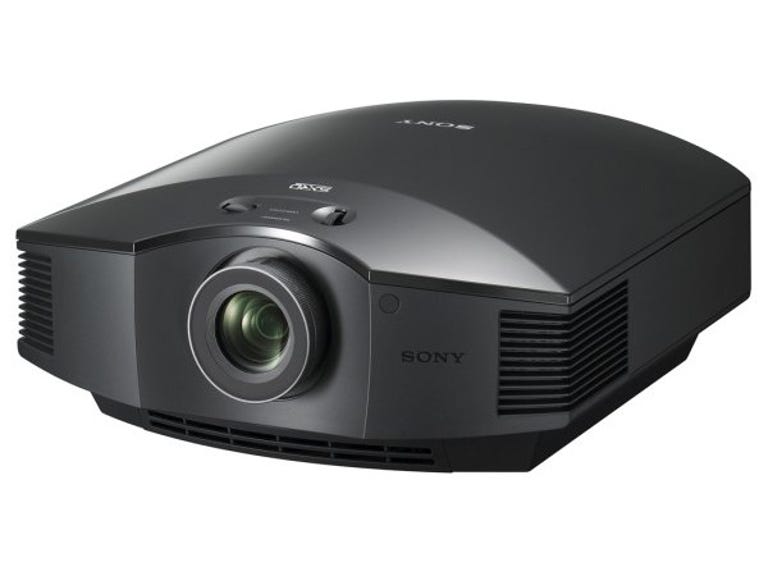 Why You Can Trust CNET
Why You Can Trust CNET Sony VPL-HW30ES Home Theatre Projector review: Sony VPL-HW30ES Home Cinema Projector
The Sony VPL-HW30ES is a fine all-round home-cinema projector with good-quality 3D, but you'll need to do a bit more wiring than normal.
System
Sony uses its SXRD panels in the VPL-HW30ES. These used to be confined to its higher-cost projectors, with the lower-cost ones scoring LCD. SXRD stands for Silicon X-tal Reflective Display, which is to say that it is Sony's version of LCoS (Liquid Crystal on Silicon), a solid-state reflective technology.
The Good
The Bad
The Bottom Line
There are three full HD panels used, one for each primary colour. Combined with the projector's dynamic processing, they offer a claimed 70,000:1 contrast ratio.
The input selection is cut down to two HDMI, component and VGA. The other old analog standards have been shed. There is also an RS-232C socket for system integration, and a socket for an external IR receiver, but no trigger to control other gear.
The lens offers a reasonably flexible 1.6:1 zoom range, plus manually operated horizontal and vertical lens shift, so installation location isn't too constrained.
You get most of the necessary goodies with the projector for 3D: two sets of 3D glasses and an external 3D transmitter. There is a matching socket on the projector for this last, but you will need standard Ethernet cable to connect the two, a longish one if you're putting the transmitter at the front of the room. We tried putting the transmitter on the projector, but in our test labs it was not able to reflect sufficient signal back from the projection screen to work, so it had to go at the front.
The glasses use, unfortunately, rechargeable batteries. They charge from USB sockets using supplied cables. This is inevitably less convenient than those that use disposable button cells, but at least Sony tosses in a USB charger, so you don't need to leave them hanging out of your computer's USB sockets.
2D performance
As a rule, the 2D performance of this projector is very good indeed. But only after a bit of intervention.
By default, the projector fired up in "Cinema 1" picture mode. This was a particularly unpleasant one, especially compared to "Standard" (which wasn't the default). The reason soon became apparent: "Cinema 1" has its "Sharpness" control turned up to 70 on a scale of 100. This produced nasty ringing on the hard edges of content. Usually, "Cinema" picture settings on projectors are a bit too mellow and soft. This one was too harsh, thanks to that setting. Wind it down to about 20, and things are a lot better.
The projector also fired up with its lamp on high output (adjust this under "Cinema Black Pro") and its cooling fans on the higher setting, so it was a bit on the noisy side. Turning the lamp to "Low" still allowed plenty of brightness in our darkened office, and reduced the fan noise. Switching the fan also to low made the projector very nearly silent.
Black levels were also improved with the lower lamp brightness, allowing good low-level detail in dark scenes.
Simple changes, those are, that will deliver much better results.
Sony has the best judder-removal system on the market, under the name "Motion Flow". Somehow, it manages to avoid the spurious noise that most other systems develop, and also the peculiar glossiness that results from the semi-averaging of frames in motion interpolation. Feel free to use it knowing that the only damage done to the picture by this system is to remove the natural defects involved in the art of cinematography.
3D performance
The 3D performance was quite reasonable, if a little difficult to understand. First, brightness was fine. The projector automatically switched to high output from the lamp when in 3D mode, offsetting the dimming effect of the 3D glasses.
The 3D crosstalk performance was largely quite good, as well. Ghosting was visible when looked for, but not intrusive, and it didn't do anything to reduce the 3D effect. But it was a bit inconsistent. A scene we frequently pause on for its ability to reveal ghosting showed very good performance in the middle of the screen, but significantly darker ghosts near the top of the screen (top, in this case, being at the nominal bottom of the projected image, since we had the unit installed upside down on our ceiling mount). That was strange, because we normally expect timing issues to control crosstalk, not location on the screen.
Perhaps there are some polarisation issues of which we are unaware.
We double checked this with a crosstalk test pattern, and this seemed to show that the closer the content is to the bottom of the screen (with the projector inverted), the better the performance. Indeed, the results on the bottom half of the screen were the best we have seen, other than with a DLP projector, but on the top of the screen there was noticeable breakthrough of whites into what should have been black, plus colour shift of black content to a dark maroon.
Overall
Nonetheless, the 3D was perfectly usable, just not as good as some of the competition. Still, this was a solid all-round performer
.

